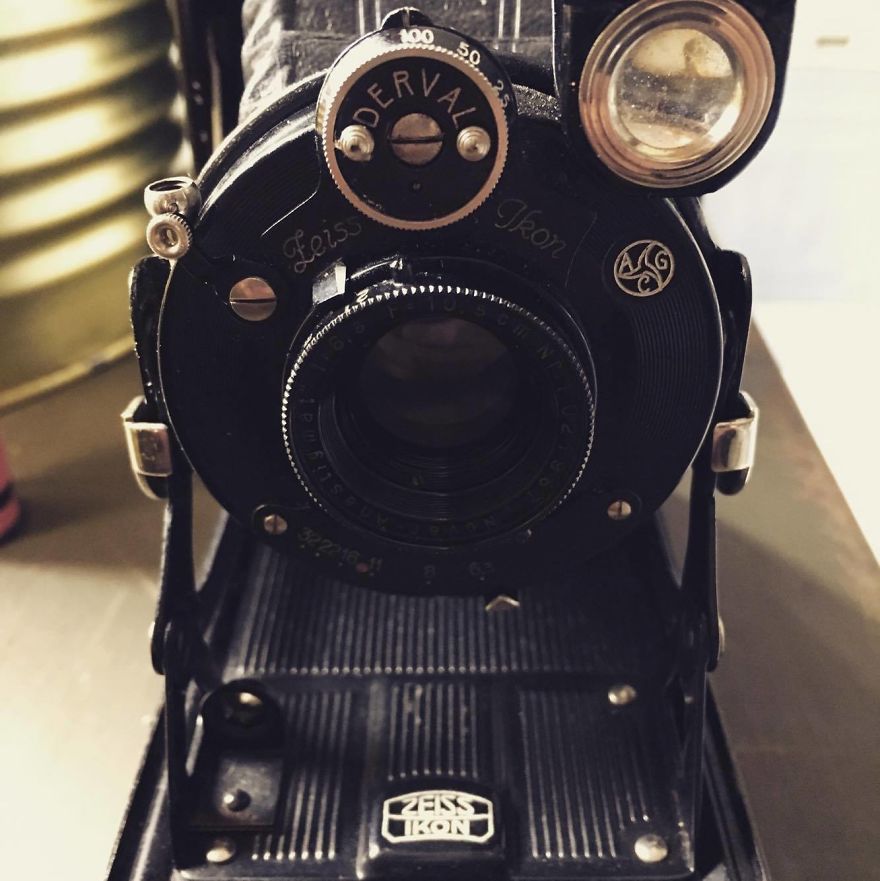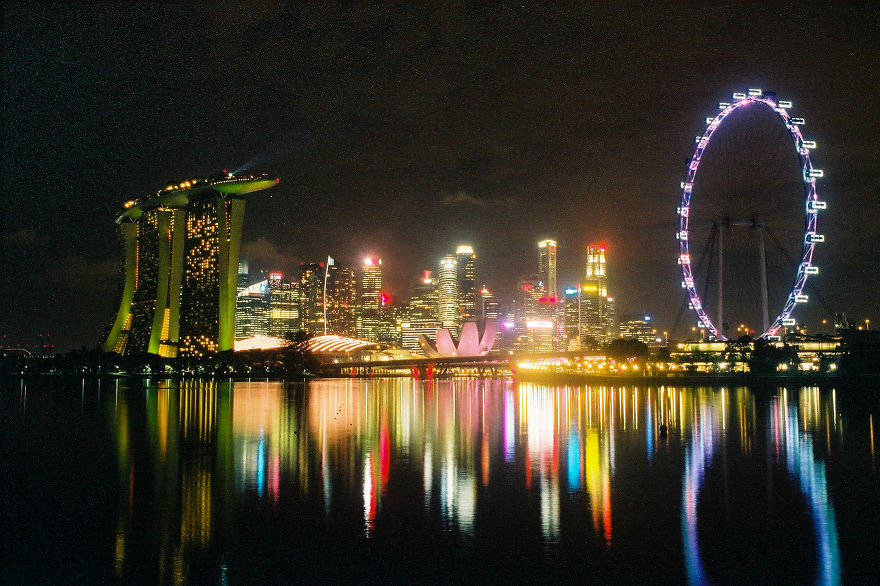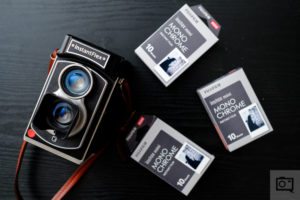
12 Things Not To Do When Buying Your First Film Camera You’ve got your flannel and your beanie and you’re ready to buy your first film camera. So… now what? I can’t tell you exactly what to do, because then you’d risk turning into me, which means drowning in an ever-deepening lake of 35mm SLRs, but I can tell you a few things to avoid.
Here are a dozen things you should try not to do when buying your first film camera.
Images by Dan Bracaglia except where noted
1. Don’t worry about buying 'the best' camera
Here’s a tidbit that’s a bit of a mind-bender for some digital photographers: When it comes to film photography, the camera body itself has very little bearing on image quality. In the digital world, an entry-level Nikon D40 simply cannot achieve the same image quality as a high-end Nikon D5, but with film, a low-end Nikon N55 really can make just as good a picture as a pro-level Nikon F6. It’s the lens and film choice that really impact the technical quality of your pictures.
Find a good working camera that you like, because with film, good is good enough
All a film camera does is hold the film in place and facilitate its exposure. More advanced cameras give you more options for doing this, but they don’t necessarily do the job any better, to the point that few people can tell the difference between a photograph made with a $5,000 Leica and one made with a $50 Minolta. As long as the camera has a decent lens—and most lenses made by camera manufacturers are pretty decent—the capability for an image of good technical quality is there. (Good composition is up to you. ) So don’t get caught up in trying to find the best camera—just find a good working camera that you like, because with film, good is good enough.
Photo: Nikon
2. Don’t assume a more expensive camera is a better camera
Used film camera prices are subject to all sorts of forces, including nostalgia. As a result, popular 'student' cameras like the Pentax K1000 and Canon AE-1 often command prices out of line with their feature set. In fact, in the topsy-turvy world of used film cameras, some of the most advanced cameras are among the cheapest. The N8008, Nikon’s top-of-the-line 'prosumer' camera in the late 80s, was priced three times higher than the entry-level Pentax K1000 when both were new. Today it’s the K1000 that costs three (or more) times as much.
Used film camera prices are subject to all sorts of forces, including nostalgia
Brand reputation also plays a big (and sometimes outsized) role. The Nikon FE, a magnificent manual-focus SLR with an aperture-priority automatic mode, sells in the $75 to $150 range, a good deal for a Nikon of that era. But the Ricoh KR-10 offers most of the same features, and you can easily find one for $35 or less. I own both cameras, and while the Ricoh is less refined, it makes equally good photos. (How do you find out what a camera can do? Camera-wiki. org is a great resource for looking up specs and features. )
Photo: John Nuttall
3. Don’t be afraid of electronic cameras
There are a lot of mechanical camera snobs out there; I’m one of them. But some of the arguments for going all-mechanical aren’t relevant to all film shooters (Sure, they work if the batteries fail, but their light meters won't). Mechanical cameras like the Nikon FM, Olympus OM-1 and Pentax MX are robust but expensive. Cameras with electronically timed shutters (which need a battery for the shutter to work) usually sell for less, and many all-electronic autofocus cameras are even cheaper.
It’s sometimes more cost effective to replace a broken electronic camera than to fix a mechanical camera
Electronic cameras do have some key advantages over mechanical cameras, particularly for first-timers. They have fewer moving parts and are less prone to going out of adjustment than mechanical cameras. That means that if they work, they probably work correctly, with accurate metering and shutter timing (which is why camera manufacturers switched over to electronics in the first place). Repairs can be dicey because they often rely on 'donor' cameras for electronic parts, which are subject to the same age-related issues. But because they are so cheap, it’s sometimes more cost effective to replace a broken electronic camera than to fix a mechanical camera.
Photo: John Nuttall
4. Don’t buy a camera without researching lenses
The obsession with lens optics is the film equivalent of pixel-peeping. In truth, few people can look at a photo and tell if it was shot with a Nikkor, a Rokkor or a Takumar. The differences in quality between the camera manufacturers’ lenses* is narrow, but the price differences can be massive. (It’s a different story with third-party lenses, which vary in quality. ) Remember, an inexpensive camera isn’t inexpensive if it locks you into pricey lenses.
An inexpensive camera isn’t inexpensive if it locks you into pricey lenses
The general wisdom is that manual-focus cameras are best paired with prime (fixed focal length) lenses, as the optical quality of zooms from that era wasn’t great. Also, primes tend to have larger maximum apertures for low light. Zoom technology improved in the mid-to-late 80s, so they’re a safer bet for autofocus cameras. You’ll need to do some research on lens compatibility (which can get confusing—for example, Nikon has used the same lens mount for decades, but not all lenses are fully functional with all cameras). Don’t know where to start? For 35mm SLRs, a 50mm lens with a max aperture between F2 and F1. 4 is a good first lens, and for autofocus cameras, a zoom in the neighborhood of 28-85mm works nicely. Or you can just buy a rangefinder, compact or bridge camera with a non-detachable lens.
* Some camera manufacturers used different brand names for their lenses. Nikkor = Nikon, Rokkor = Minolta, Takumar = Pentax, Zuiko = Olympus, and Rikenon = Ricoh.
5. Don’t get a camera that’s too automatic… or too manual
Film cameras have different levels of automation. Some only have manual exposure control, requiring the photographer to set both aperture and shutter speed. Some require you to pick one (usually aperture) and will set the other for you. Still others have 'program' modes that do everything. Focusing and winding can be manual or automatic as well.
A manual-focus camera with both manual and automatic exposure modes is a great way to start
I recommend avoiding automatic-exposure-only cameras as a first-time buy. While they take great pictures, it’s nice to have the option to set your exposure manually and really take control of the process. On the other hand, an all-manual camera can be frustrating if you’re used to digital-era automation. A manual focus camera with both manual and automatic exposure modes is a great way to start. You can shoot in automatic as you get the hang of focusing and winding (which takes more getting used to than you might think), then switch to manual when you're ready. Some good examples of these cameras include the Nikon FE2, Minolta X-700 and Canon AE-1. If you buy an autofocus SLR, look for one that has a manual mode.
6. Don’t buy a camera that hasn’t been tested
If you’re buying on an auction site, check the description and see if the camera has been tested. If it doesn’t say, ask. Working, for a film camera, means that the light meter turns on, the shutter fires at all speeds, the film and battery doors latch shut, the film advance moves freely, and autofocus, auto-wind, and self-timer functions, if present, are operational. Not every seller knows this, but you do, and if the seller says the camera works and it doesn’t, you have grounds for a refund. 'Not tested' or 'parts' cameras are a crapshoot. If you’re squeamish, shop at a local camera store or an established dealer like KEH. You’ll pay a bit more, but you’ll know what you’re getting.
Shop at a local camera store or an established dealer like KEH. You’ll pay a bit more, but you’ll know what you’re getting
Should you buy a non-working camera? Probably not for your first one, but don’t rule it out. Most issues with mechanical cameras, and some better-made electronic cameras, can be fixed as part of a CLA (cleaning, lubrication and adjustment) service, which generally costs $100 and up, and this may be worthwhile for a more valuable camera or a model you really want. Once CLA'd, a camera should work for years without needing further attention. Find a good film camera repair shop and get their opinion on whether a given camera is worth fixing.
Photo: Gerry Lauzon
7. Don’t buy a camera that doesn’t focus
If you’re looking at compact point-and-shoot cameras, you should be aware of the difference between autofocus and focus-free. Autofocus is exactly what you think it is. Focus-free cameras have a small lens aperture and rely on depth-of-field to get your shot in focus. These cameras often don’t have much in the way of exposure control, either; they rely on the built-in flexibility of the color print film process to get good pictures out of close-enough exposures.
If the camera is a cheap plastic affair with a name you’ve never heard of, there’s a good chance it’s focus-free
Believe it or not, there were focus-free cameras made by big-name brands like Olympus, Minolta and Kodak as well as cheap-camera purveyors like Vivitar, Argus and Keystone. Most of these will say 'Focus Free' on the body. If the camera is a cheap plastic affair with a name you’ve never heard of, there’s a good chance it’s focus-free.
Photo: E Magnuson
8. Don’t buy a used 'pro' 35mm camera
When you see a legendary top-of-the-line camera like a Nikon F4 or Canon EOS-1n come up on eBay for a fraction of its original price, it can be tempting to slam that 'BUY NOW' button. These cameras were the best of the best in their day, listing for upwards of $2,000, and the idea of buying one for a couple hundred bucks is pretty darn tasty. Resist! Resist!
Better to stick to high-end 'advanced amateur' cameras, which have similar features to the pro cams but usually led easier lives
Here’s the problem: A lot of these cameras were purchased by working professional photographers, which means they were used often and hard. Like DSLRs, film cameras with electronic shutters have finite shutter lives, and even mechanical shutters can wear out. An avid shutterbug averaging two 35mm rolls a week will take around 3,800 pictures per year, but a busy wedding or news photographer can take that many snaps in a month. If the shutter goes south, replacing it can cost more than the camera is worth. Better to stick to high-end 'advanced amateur' cameras, which have similar features to the pro cams but usually led easier lives.
Photo: ShikikanZero
9. Don’t buy a medium-format camera (yet)
Medium format cameras produce big, beautiful negatives that can be enlarged to ridiculous sizes. But the bigger the image, the more money you’ll spend, both for cameras* and film. If you’re just starting out in film, 35mm offers you a lot more camera and lens choices at a lower price point. If you find you’re in love with film, you can always move up to medium format later.
If you find you’re in love with film, you can always move up to medium format later
* Okay, not always. Plastic cameras like the Holga and the Diana (sometimes called 'toy' cameras) are inexpensive, but they have imperfect plastic lenses and the occasional light leak, which injects a random element into one’s photography. Some people like that look (I think it’s pretty darn cool), but they aren’t a real alternative to a professional-quality cameras from Mamiya, Rolleiflex, Hasselblad or Pentax. Another exception: Older twin-lens reflex (TLR) cameras, which were popular with snap-shooters before the rise of smaller film formats. They offer limited creative control but can make beautiful photos.
Photo: Classic-Photographic
10. Don’t start out with good film
Buying a used camera always carries an element of risk, and I can imagine few things that will turn off a first-time film photographer more than spending a lot of money on film and processing and getting back a roll of unusable negatives. Save that Ektar, Portra or Cinestill film for later. The first film you shoot in any new-to-you camera should be a 24-exposure roll of the cheapest freshest (not expired) print (not slide) film you can buy.
The first film you shoot in any new-to-you camera should be a 24-exposure roll of the cheapest freshest film you can buy
Fire off a quick few exposures close to home. Try to include a variety of subjects of different textures and brightness, and shoot at different distances. If possible, use a variety of apertures and shutter speeds. Get the film processed and check the negatives carefully. If you don’t have experience evaluating negatives, your lab can help you find signs of light leaks or improper exposure, as can your friends on the DPReview film forum. Once you’re sure your new camera works, you can confidently load up the good stuff.
11. Don’t buy just one camera
Back in The Day, it was common to carry two cameras in your gear bag. Unlike digital, a film camera can’t change ISO on the fly or switch seamlessly between color and black-and-white, at least not without unloading and reloading. A second camera gives you options: You can shoot the same scene in color and B&W, or you can run faster film if the clouds roll in or the action moves indoors. And it’s nice to have a backup in case your primary camera craps out.
A $35 Pentax MG makes a great backup for a $350 Pentax LX
If you use an interchangeable-lens camera, owning two compatible camera bodies means less gear to carry. They needn’t even be the same model: A $35 Pentax MG makes a great backup for a $350 Pentax LX (or a Nikon EM + FM2). I wouldn’t necessarily buy two cameras right off the bat, but if you find a camera and a set of lenses you like, a second compatible camera body is a smart investment.
12. Don’t spend too much money just yet
I think film photography is wonderful, but it’s not for everyone. You might get some film experience under your belt and decide you prefer digital, and that can be a real tragedy if you’ve spent $500 on gear. There are plenty of good cameras available for $100 or less (often a lot less), so start with something more modest.
Cameras hold their value well, so if you decide you’re just not a film shooter, you can sell your gear at a minimal loss
Cameras hold their value well, so if you decide you’re just not a film shooter, you can sell your gear at a minimal loss—or give it to someone else who wants to try film. If you do fall in love, as so many of us have, you can always buy something more expensive, though I can all but guarantee that your first film camera will always have a special place in your heart.
Ready to start the hunt for your first film camera? Here are some of our all-time favorite analog gems, most of which are affordable and easy to find in good working order (though not all follow the advice of this article!):
Analog gems: 20 film cameras worth buying right now
. dpreview.com2020-5-29 17:00









